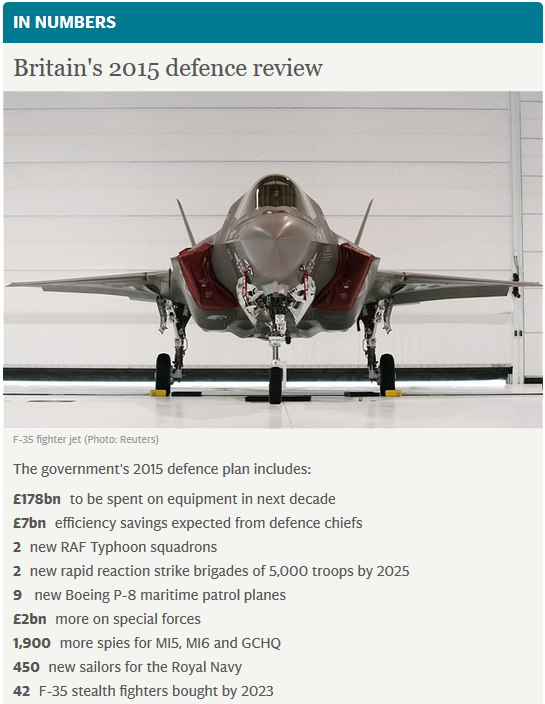Back in 2010, the British government published the Strategic Defence and Security Review (SDSR), which I joked should properly have been called the “Slashing Damage to Strategic Resources” plan. Back then, the strategic picture was fairly undisturbed with no obvious rising threats, but the economy was still in bad shape. That meant that the RN, RAF, and the army had to cut, cut, cut (and cut some more). The next version of that document has just been published and this time it’s been joined to the National Security Strategy in a single document. Patrick Bury looks at how things have changed from SDSR 2010 to the new NSSSDSR 2015:
On Monday, Prime Minister David Cameron unveiled Britain’s new National Security Strategy and Strategic Defence and Security Review in the House of Commons. It marked the first time the United Kingdom has undertaken a review of its strategy and security within the new five-year schedule. This edition is also notable in that it combines the National Security Strategy (NSS) and Strategic Defence and Security Review (SDSR), which were previously two separate documents. True to its name, the NSS outlines the perceived threats to Britain and its vision for dealing with them, while the SDSR details how the armed forces are configured to execute this vision.
These developments point to a realization in the United Kingdom that it must be more flexible and responsive in terms of setting strategy and defense priorities. After introducing the NSS in 2010 in the wake of criticism that Britain “couldn’t do strategy,” the Conservative government clearly feels it now makes sense to present both policies in a single document. Similarly, the overarching tone of the document is one of internationality. Britain clearly believes it will be working with the United States and France especially closely in the future. But what is inside, and what does it mean?
The NSS related-chapters outline the usual myriad of threats commonly listed in the post-Cold War era. Based on the security services’ National Security Risk Assessment, these threats are then classed into tiers. Tier One risks are the highest priority based on high likelihood and/or high impact. Reflecting the impact of threats and hazards, and the development of risks since 2010, the latest assessment includes a greater number of Tier One risks than in 2012. These are listed in order as terrorism, cyber, international military conflict (rising since 2010), instability overseas (Tier Two in 2010), public health (a new addition), and natural disasters. Interestingly, the general erosion of international order and resulting chaos also makes a more significant appearance.
Here’s the quick overview of what is promised this time around:
One area that looks concerning is that the British government appears to be considering replicating the Canadian experiment with merging the military services into a “unified” structure:
Tying all these developments together, this SDSR is notable for its underlying shift towards viewing Britain’s smaller services as a single force, as unveiled in the new Joint Force 2025. Over the next decade, the core of the Joint Force will be based around an expeditionary force of around 50,000 (compared with around 30,000 planned in 2010’s Future Force 2020) and is set to include a new F-35 equipped aircraft carrier, “a land division with three brigades including a new Strike Force; an air group of combat, transport and surveillance aircraft,” and a special forces task group. Of course, the Whole Force concept underpins jointness, but one gets the sense that future SDSRs may well pave the way for the merging of all three services into one force in the name of flexibility and in the search for efficiencies. Another interesting nuance was the primacy of special forces in the document – above that of the Royal Navy which is the senior service – perhaps an indication of why the government is investing an extra £2 billion ($3 billion) in its equipment as well. The number of staff at GCHQ (the signal-intelligence agency), MI5 and MI6 (the domestic and foreign intelligence services) is to also increase by 1,900.
Despite this SDSR unveiling the first major investment, rather than reductions, in the United Kingdom’s security forces for about 25 years, there are a number of noticeable gaps. The first concerns its people. The army remains at its smallest size since the Napoleonic era; recruitment and retention is a problem across British defense; and it remains to be seen if the government’s Spending Review released tomorrow will better the terms and conditions of service. Without the right people in the right place, all the fancy kit in the world is not much use. The message is also clear that rapid-reaction forces are in fashion, and boots on the ground and long-term counter-insurgency operations are out, at least for now. The now bit is important: with a lot of these investments and the Joint Force structure not scheduled for delivery for ten years, there is plenty of scope to adjust or change course entirely between now and then. Which is exactly how the Brits do long-term strategy. Nevertheless, this SDSR is clearly intended to show that Britain wants to remain in the top tier of international powers over the coming decade.




